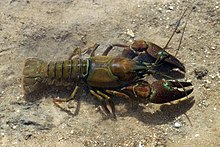Signal crayfish
| Signal crayfish | |
|---|---|

| |
| Scientific classification | |
| Kingdom: | |
| Phylum: | |
| Subphylum: | |
| Class: | |
| Order: | |
| Family: | |
| Genus: | |
| Species: | P. leniusculus
|
| Binomial name | |
| Pacifastacus leniusculus | |
The signal crayfish, Pacifastacus leniusculus, is a North American species of crayfish. It was introduced to Europe in the 1960s to supplement the Scandinavian Astacus astacus fisheries, which were being damaged by crayfish plague, but the imports turned out to be a carrier of that disease. The signal crayfish is now an invasive species, ousting native species across Europe and Japan.
Description and ecology

Members of this species are typically 6–9 centimetres (2.4–3.5 in) long, although sizes up to 16–18 cm (6.3–7.1 in) are possible.[2] They are bluish-brown to reddish-brown in colour with robust large smooth claws. They have a white to pale blue-green patch near the claw hinge.[3]
The life cycle of the signal crayfish is typical for the family Astacidae. Around 200–400 eggs are laid after mating in the autumn, and are carried under the female's tail until they are ready to hatch the following spring.[2] The eggs hatch into juveniles which pass through three moults before leaving their mother. Sexual maturity is reached after 2–3 years, and the life span can be up to 20 years.[2]
The signal crayfish is an omnivore, with most of the dietary intake being detritus.[4]
Native range
The signal crayfish is native to North America west of the Rocky Mountains, including the Canadian province of British Columbia, and the U.S. states of Washington, Oregon, Idaho, California and Utah.[5] Within North America, it has also been introduced to Nevada, and the populations in Utah may be the results of introductions.[5]
Introduction
From 1907, crayfish plague, an infectious disease caused by the water mould Aphanomyces astaci, damaged stocks of the native European crayfish Astacus astacus. Since the signal crayfish occupied a similar ecological niche in its native range, it was imported in the 1960s to Sweden and Finland to allow recreational and commercial crayfish capture.[2] It was not realised at the time that the signal crayfish was a carrier of the crayfish plague.[2] All American species carry the infection, but it is only lethal to individuals that are already stressed; to European species, the infection is rapidly fatal.[6]
The signal crayfish is now the most widespread alien crayfish in Europe, occurring in 25 countries, from Finland to Great Britain and from Spain to Greece.[2] It was first introduced to Great Britain in 1976, and is now widespread across the island as far north as the Moray Firth. It has also been observed on the Isle of Man, but has not yet been introduced to Ireland.[6]
External links
- "Invasion of the Plague Carriers" (RealVideo). The Vega Science Trust. 2002.
- "'Kill crayfish on sight' appeal". BBC News. August 15, 2008.
 Media related to Pacifastacus leniusculus at Wikimedia Commons
Media related to Pacifastacus leniusculus at Wikimedia Commons
References
- ^ "Pacifastacus leniusculus (Dana, 1852)". Integrated Taxonomic Information System. Retrieved August 28, 2010.
- ^ a b c d e f Trond Taugbøl & Stein I. Johnsen (2006). "Invasive Alien Species Fact Sheet – Pacifastacus leniusculus" (PDF). Online Database of the North European and Baltic Network on Invasive Alien Species. NOBANIS – European Network on Invasive Species. Retrieved August 28, 2010.
- ^ Mike Averill (1997). "Crayfish in Worcestershire". Worcestershire Record. 2: 4.
- ^ Carin A. Bondar, K. Bottriell, K. Zeron & John S. Richardson (2005). "Does trophic position of the omnivorous signal crayfish (Pacifastacus leniusculus) in a stream food web vary with life history stage or density?" (PDF). Canadian Journal of Fisheries and Aquatic Sciences. 62: 2632–2639. doi:10.1139/F05-167.
{{cite journal}}: CS1 maint: multiple names: authors list (link) - ^ a b James W. Fetzner, Jr. (January 14, 2008). "Pacifastacus (Pacifastacus) leniusculus leniusculus (Dana, 1852). Signal crayfish". Crayfish Taxon Browser. Carnegie Museum of Natural History. Retrieved August 8, 2010.
- ^ a b Richard Chadd & Brian Eversham (2010). "Other invertebrates". In Norman Maclean (ed.). Silent Summer: The State of Wildlife in Britain and Ireland. Cambridge University Press. pp. 556–575.
